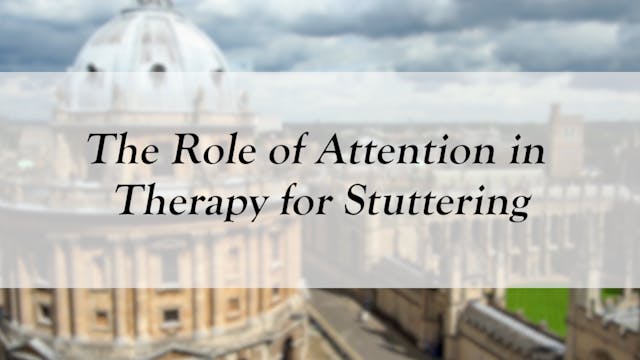Neurological Insights into Dysfluent Speech Production: Challenges and Changes
11th Oxford Dysfluency Conference Package ($60)
•
1h 4m
Dr. Martin Sommer writes, "Fluent speech is a fundamental prerequisite for social interaction in humans and a challenging task for the brain. Not all children acquire fluent speech; therefore stuttering persists after puberty in about 1 percent of adults. In recent years a broad range of technical innovations has allowed new insights into kinematics, underlying brain structure, brain function and the neurophysiology of fluent and dysfluent speech.
Studying speech production is being improved by real-time very fast structural MR imaging observing the kinematics of articulators while speaking. This gives a substantiated insight into dysfluent speech patterns and will allow answering the question whether fluent sounding speech units are typically articulated in adults who stutter.
A better insight into brain structure has been made possible by magnetic resonance imaging of water diffusion in the brain. It has uncovered a reduced integrity of white matter tracts, mostly in left inferior frontal areas. This has opened a whole new perspective to view stuttering as a speech area disconnection syndrome, and has motivated pioneering work from the Michigan group on longitudinal brain imaging studies in children who stutter.
With its excellence time resolution, electroencephalography gives insight into the interplay of brain areas during speech preparation and shows an imbalanced timing of the activity of left hemispheric speech motor areas. The electrophysiological technique of transcranial magnetic stimulation enables investigating speech preparation with a very high time resolution, in order to assess speech preparatory processes of motor areas representing articulatory muscles. This allowed discovering an imperfect speech preparation in adults who stutter as a pathophysiological basis of dysfluent speech. It will allow differentiating a lack of facilitation from an excessive inhibition.
Furthermore, transcranial magnetic stimulation gives a window on the hemispheric distribution of speech and non-speech related activations of articulatory muscles and as well as of hand muscles.
In addition to technical advances, rare clinical cases on cerebellar lesions that modulate speech fluency further substantiate the structural basis of fluent and dysfluent speech production.
Finally, refined questionnaires allow assessing the so-called anticipation of speech dysfluencies, which is the premonitory awareness that something is about to go wrong with speech fluency. We have assessed this in detail by deriving a questionnaire from Tourette’s syndrome to assess reliability and linguistic specificity of this premonitory awareness of dysfluencies in adults who stutter.
Hence, the results of the last 20 years of research improve our understanding of dysfunctional nodes in speech networks, thereby refining and detailing current models of speech production. Beyond that, they expand future possibilities to study speech network modulation by therapy or external stimulation."
Up Next in 11th Oxford Dysfluency Conference Package ($60)
-
The Role of Attention in Therapy for ...
Presenter, Jane Harley writes, "My interest in the process of attention in stuttering therapy stems initially from a background in CBT and the information-processing theory and models which underpin CBT. These theoretical models propose that biases in what individuals attend to contribute to the ...
-
Bilingualism and Stuttering: Typical ...
Dr. Courtney Byrd writes," Speech disfluencies provide valuable insight into the linguistic and motoric effort required for spoken communication. Expressions such as “second language fluency” and “word fluency” tasks reflect this concept. The types and frequencies of speech disfluencies children ...
-
The Teenage Brain: Understanding Deve...
Dr. Catherine Sebastian writes, "Adolescence is a key developmental window characterised by profound changes in cognitive, social and emotion skills. While the majority of young people negotiate the pressures of adolescence well, this stage of life is nonetheless characterised by an increase in r...


